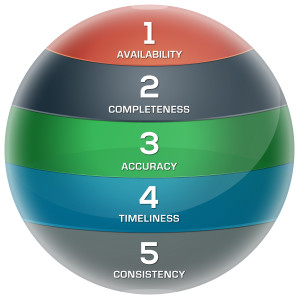Data quality is a term that refers to the reliability and validity of user-level data collected in the Authoritative Systems that feed your Identity and Access Management system (IAM). Quality is measured by how accurately the user data in the system reflects actual information available in the real world. In Part I of this series, we made the case that good data quality is essential to have a functional identity and access management solution. With good data quality, an IAM solution will be able to manage the user lifecycle automatically and grant and revoke access as the user relationship evolves through promotions, transfers, and separation.
We can assess the quality of data available to us by evaluating each Authoritative Source across the following 5 Dimensions:
1 – Availability –  Do we have the necessary data to create a functional user identity?
Do we have the necessary data to create a functional user identity?
In order to create and manage a user identity, there has to be an Authoritative Source to provide the data. Note that inaccurate information is generally worse than incomplete information, since in the latter case you are always aware of the gap.
2 – Completeness – Is each required data element populated in the system?
Data can be omitted if not collected/ entered during the onboarding process into the Authoritative Source. Missing data (for example, a missing Cost Center) can negatively affect the ability of IAM to provide appropriate application access to users, route approvals, and perform other routine tasks.
3- Accuracy – Are the data correct?
Accurate data ensures that the transactions from your IAM solution are based on the best possible representation of reality as it relates to the user. Accuracy can be difficult to assess as it depends on the user, manager, or other person providing correct data. Additionally, poor documentation and sloppy data entry processes can undermine accuracy, which is best determined by comparing user records in the HRIS system to paper records, or the records of another reliable provider.
4 – Timeliness – Are the data available when needed?
Timeliness ensures data is accessible when needed and is often dependent on the supporting Human Resources (HR) onboarding processes, Service Level Agreements, and business drivers, such as payroll deadlines. In way of example, if a new employee is hired and has two weeks before her first paycheck, HR staff may not be required to enter the new hire until payroll hits, which introduces a 14-day delay in the provisioning process.
5 – Consistency – Are the data stored in the same format across different systems?
The ability to consume data and store it in the proper user attribute is dependent upon a common definition of data fields across authoritative systems. For this dimension, establishing IAM governance and organizational standards is key.






